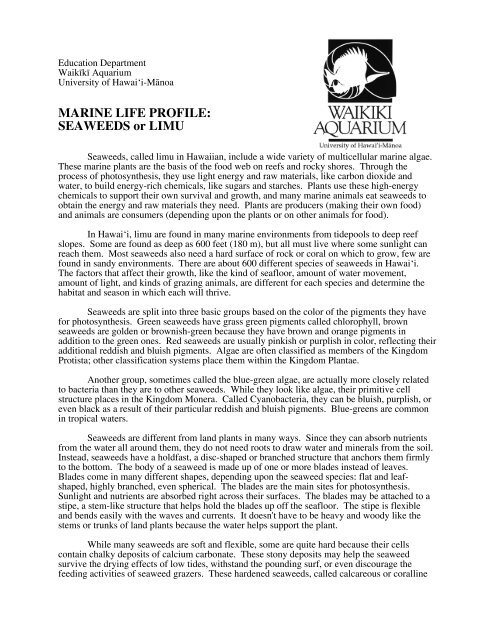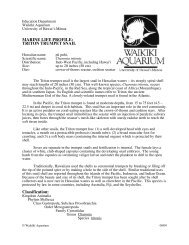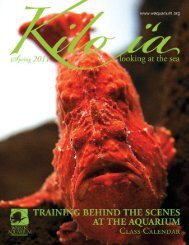You also want an ePaper? Increase the reach of your titles
YUMPU automatically turns print PDFs into web optimized ePapers that Google loves.
Education Department<br />
Waikïkï Aquarium<br />
University of Hawai‘i-Mänoa<br />
MARINE LIFE PROFILE:<br />
SEAWEEDS or LIMU<br />
Seaweeds, called limu in <strong>Hawaiian</strong>, include a wide variety of multicellular marine algae.<br />
These marine plants are the basis of the food web on reefs and rocky shores. Through the<br />
process of photosynthesis, they use light energy and raw materials, like carbon dioxide and<br />
water, to build energy-rich chemicals, like sugars and starches. Plants use these high-energy<br />
chemicals to support their own survival and growth, and many marine animals eat <strong>seaweeds</strong> to<br />
obtain the energy and raw materials they need. Plants are producers (making their own food)<br />
and animals are consumers (depending upon the plants or on other animals for food).<br />
In Hawai‘i, limu are found in many marine environments from tidepools to deep reef<br />
slopes. Some are found as deep as 600 feet (180 m), but all must live where some sunlight can<br />
reach them. Most <strong>seaweeds</strong> also need a hard surface of rock or coral on which to grow, few are<br />
found in sandy environments. There are about 600 different species of <strong>seaweeds</strong> in Hawai‘i.<br />
The factors that affect their growth, like the kind of seafloor, amount of water movement,<br />
amount of light, and kinds of grazing animals, are different for each species and determine the<br />
habitat and season in which each will thrive.<br />
Seaweeds are split into three basic groups based on the color of the pigments they have<br />
for photosynthesis. Green <strong>seaweeds</strong> have grass green pigments called chlorophyll, brown<br />
<strong>seaweeds</strong> are golden or brownish-green because they have brown and orange pigments in<br />
addition to the green ones. Red <strong>seaweeds</strong> are usually pinkish or purplish in color, reflecting their<br />
additional reddish and bluish pigments. Algae are often classified as members of the Kingdom<br />
Protista; other classification systems place them within the Kingdom Plantae.<br />
Another group, sometimes called the blue-green algae, are actually more closely related<br />
to bacteria than they are to other <strong>seaweeds</strong>. While they look like algae, their primitive cell<br />
structure places in the Kingdom Monera. Called Cyanobacteria, they can be bluish, purplish, or<br />
even black as a result of their particular reddish and bluish pigments. Blue-greens are common<br />
in tropical waters.<br />
Seaweeds are different from land plants in many ways. Since they can absorb nutrients<br />
from the water all around them, they do not need roots to draw water and minerals from the soil.<br />
Instead, <strong>seaweeds</strong> have a holdfast, a disc-shaped or branched structure that anchors them firmly<br />
to the bottom. The body of a seaweed is made up of one or more blades instead of leaves.<br />
Blades come in many different shapes, depending upon the seaweed species: flat and leafshaped,<br />
highly branched, even spherical. The blades are the main sites for photosynthesis.<br />
Sunlight and nutrients are absorbed right across their surfaces. The blades may be attached to a<br />
stipe, a stem-like structure that helps hold the blades up off the seafloor. The stipe is flexible<br />
and bends easily with the waves and currents. It doesn't have to be heavy and woody like the<br />
stems or trunks of land plants because the water helps support the plant.<br />
While many <strong>seaweeds</strong> are soft and flexible, some are quite hard because their cells<br />
contain chalky deposits of calcium carbonate. These stony deposits may help the seaweed<br />
survive the drying effects of low tides, withstand the pounding surf, or even discourage the<br />
feeding activities of seaweed grazers. These hardened <strong>seaweeds</strong>, called calcareous or coralline
Waikïkï Aquarium University of<br />
Education Department Hawai‘i-Mänoa<br />
Seaweed <strong>profile</strong> continued<br />
algae, are very important in building Hawaii's reefs - they are like cement growing between the<br />
corals, adding strength to the reef structure; they can even thrive in habitats where wave impact<br />
would break corals.<br />
Limu were very important to early <strong>Hawaiian</strong>s. More than 70 different kinds were used;<br />
eaten fresh, blended with other foods, used as spices, used as medicines, and even used in special<br />
religious ceremonies. Today, many <strong>Hawaiian</strong> residents still harvest fresh limu for food or buy it<br />
at the market. Worldwide, seaweed products are used to thicken and smooth many foods and<br />
milk-products, as well as toothpaste, beauty creams, paints, and medical products like bacterial<br />
culture plates, time-release pills, and dental impression gels.<br />
Classification:<br />
Kingdom Monera Kingdom Protista<br />
Phylum Cyanobacteria (blue-green algae) Phylum Clorophyta (green <strong>seaweeds</strong>)<br />
Phylum Phaeophyta (brown <strong>seaweeds</strong>)<br />
Phylum Rhodophyta (red <strong>seaweeds</strong>)<br />
Examples of <strong>Hawaiian</strong> Seaweeds, by Habitat<br />
High intertidal, beach or tidepool area<br />
Ahnfeltia cocinna, limu ‘aki‘aki<br />
Sphacelaria furcigera<br />
Ulva fasciata, limu pälahalaha, sea lettuce<br />
Enteromorpha sp., limu ‘ele ‘ele<br />
Padina japonica<br />
Reef flat<br />
Acanthophora spicifera, introduced species (l950’s)<br />
Codium spp, limu wawae‘iole, limu a‘ala‘ula, rat’s food sea weed<br />
Caulerpa spp.<br />
Dictoyosphearia cavernosa, bubble alga<br />
Dictyota spp., limu alani<br />
Eucheuma striatum, introduced species (1970’s)<br />
Sargassum spp., limu kala<br />
Gracilaria spp., limu manauea, ogo<br />
Laurencia spp., limu mäneoneo, limu liep‘epe‘e<br />
Hypnea musiformis, introduced species<br />
Lyngbya majuscula, swimmer’s itch seaweed<br />
Reef crest<br />
Asparagopsis taxiformis, limu kohu<br />
Porolithon spp., encrusting calcareous red algae<br />
Pterocladia capillacea<br />
Subtidal<br />
Halymenia formosa, limu lepe‘ahina, red sea lettuce<br />
Dictyopteris spp., limu lipoa<br />
Halimeda opunti<br />
SELECTED HAWAIIAN SEAWEEDS (LIMU)<br />
2
Waikïkï Aquarium University of<br />
Education Department Hawai‘i-Mänoa<br />
Seaweed <strong>profile</strong> continued<br />
BROWN SEAWEEDS<br />
Sargassum<br />
Brown ear seaweed limu kala<br />
Padina sp. Sargassum echinocarpum<br />
©Waikïkï Aquarium<br />
©Waikïkï Aquarium<br />
RED SEAWEEDS GREEN SEAWEEDS<br />
Encrusting red coralline algae Reticulated sea lettuce<br />
Porolithon sp. Ulva reticulata<br />
SELECTED GREEN ©Waikïkï SEAWEEDS Aquarium OF HAWAI‘I<br />
3
Waikïkï Aquarium University of<br />
Education Department Hawai‘i-Mänoa<br />
Seaweed <strong>profile</strong> continued<br />
Chalky green disc algae<br />
Halimeda opuntia<br />
Reticulated sea lettuce<br />
Ulva reticulata<br />
© Waikïkï Aquarium<br />
4<br />
© Waikïkï Aquarium
Waikïkï Aquarium University of<br />
Education Department Hawai‘i-Mänoa<br />
Seaweed <strong>profile</strong> continued<br />
© Waikïkï Aquarium<br />
SELECTED RED SEAWEEDS OF HAWAI‘I<br />
Encrusting Red Coralline Algae<br />
Porolithon sp.<br />
5
Waikïkï Aquarium University of<br />
Education Department Hawai‘i-Mänoa<br />
Seaweed <strong>profile</strong> continued<br />
Brown ear seaweed or<br />
limu pepeiao<br />
Padina spp.<br />
© Waikïkï Aquarium<br />
SELECTED BROWN SEAWEEDS OF HAWAI‘I<br />
6<br />
Sargassum<br />
limu kala<br />
Sargassum echinocarpum<br />
© Waikïkï Aquarium








